Integrating Remote Sensing and Machine Learning for Actionable Flood Risk Assessment: Multi-Scenario Projection in the Ili River Basin in China Under Climate Change
Abstract
1. Introduction
2. Materials and Methods
2.1. Study Area
2.2. Data
2.2.1. Flood Inventory Map
2.2.2. Flood Conditioning and Impact Factors
2.3. Methodology
2.3.1. Multi-Temporal Satellite-Based Inundation Mapping
2.3.2. Machine Learning Methods
2.3.3. Model Performance Evaluation
2.3.4. Flood Risk Assessment
3. Results
3.1. Analysis of Historical Inundation Patterns
3.2. Comparative Performance Evaluation of Machine Learning
3.3. Flood Risk
3.3.1. Flood Hazard
3.3.2. Flood Vulnerability
3.3.3. Flood Risk
4. Discussion
4.1. Flood Risk Assessment Integrating Remote Sensing and Machine Learning
4.2. Flood Risk Changes in SSP-RCP Scenarios
4.3. Indications for Flood Risk Management
4.4. Limitations of the Study
5. Conclusions
Author Contributions
Funding
Data Availability Statement
Conflicts of Interest
References
- CRED; UNDRR. The Human Cost of Disasters: An Overview of the Last 20 Years (2000–2019). Available online: https://www.undrr.org/publication/human-cost-disasters-overview-last-20-years-2000-2019 (accessed on 17 February 2025).
- IPCC. Climate Change 2021—The Physical Science Basis: Working Group I Contribution to the Sixth Assessment Report of the Intergovernmental Panel on Climate Change; Cambridge University Press: Cambridge, UK, 2023. [Google Scholar]
- Clement, V.; Rigaud, K.K.; de Sherbinin, A.; Jones, B.; Adamo, S.; Schewe, J.; Sadiq, N. Groundswell Part 2: Acting on Internal Climate Migration. Available online: https://hdl.handle.net/10986/36248 (accessed on 17 February 2025).
- UNDRR. GAR Special Report 2023: Mapping Resilience for the Sustainable Development Goals. Available online: https://www.undrr.org/gar/gar2023-special-report (accessed on 17 February 2025).
- Wang, L.H.; Cui, S.H.; Li, Y.Z.; Huang, H.J.; Manandhar, B.; Nitivattananon, V.; Fang, X.J.; Huang, W. A review of the flood management: From flood control to flood resilience. Heliyon 2022, 8, 12. [Google Scholar] [CrossRef] [PubMed]
- Yang, R.T.; Wang, G.J.; Zhang, Y.X.; Zhang, P.; Li, S.J.; Cabral, P. Cropland Exposure to Extreme Dryness and Wetness in China Under Shared Socioeconomic Pathways. Int. J. Climatol. 2025, 45, 17. [Google Scholar] [CrossRef]
- China National Climate Change Adaptation Strategy 2035. Available online: http://big5.www.gov.cn/gate/big5/www.gov.cn/zhengce/zhengceku/2022-06/14/5695555/files/9ce4e0a942ff4000a8a68b84b2fd791b.pdf (accessed on 17 February 2025).
- Ward, P.J.; Blauhut, V.; Bloemendaal, N.; Daniell, J.E.; de Ruiter, M.C.; Duncan, M.J.; Emberson, R.; Jenkins, S.F.; Kirschbaum, D.; Kunz, M.; et al. Review article: Natural hazard risk assessments at the global scale. Nat. Hazards Earth Syst. Sci. 2020, 20, 1069–1096. [Google Scholar] [CrossRef]
- UNDRR. Sendai Framework for Disaster Risk Reduction 2015–2030. Available online: https://www.unisdr.org/we/coordinate/sendai-framework (accessed on 19 February 2025).
- Ming, X.D.; Liang, Q.H.; Dawson, R.; Xia, X.L.; Hou, J.M. A quantitative multi-hazard risk assessment framework for compound flooding considering hazard inter-dependencies and interactions. J. Hydrol. 2022, 607, 15. [Google Scholar] [CrossRef]
- Peng, J.Q.; Zhang, J.M. Urban flooding risk assessment based on GIS- game theory combination weight: A case study of Zhengzhou City. Int. J. Disaster Risk Reduct. 2022, 77, 13. [Google Scholar] [CrossRef]
- Zheng, J.X.; Huang, G.R. Towards flood risk reduction: Commonalities and differences between urban flood resilience and risk based on a case study in the Pearl River Delta. Int. J. Disaster Risk Reduct. 2023, 86, 15. [Google Scholar] [CrossRef]
- Rözer, V.; Peche, A.; Berkhahn, S.; Feng, Y.; Fuchs, L.; Graf, T.; Haberlandt, U.; Kreibich, H.; Sämann, R.; Sester, M.; et al. Impact-Based Forecasting for Pluvial Floods. Earth Future 2021, 9, 18. [Google Scholar] [CrossRef]
- Rathnasiri, P.; Adeniyi, O.; Thurairajah, N. Data-driven approaches to built environment flood resilience: A scientometric and critical review. Adv. Eng. Inform. 2023, 57, 21. [Google Scholar] [CrossRef]
- Nanditha, J.S.; Kushwaha, A.P.; Singh, R.; Malik, I.; Solanki, H.; Chuphal, D.S.; Dangar, S.; Mahto, S.S.; Vegad, U.; Mishra, V. The Pakistan Flood of August 2022: Causes and Implications. Earth Future 2023, 11, 17. [Google Scholar] [CrossRef]
- Luo, K.S.; Zhang, X.J. Increasing urban flood risk in China over recent 40 years induced by LUCC. Landsc. Urban Plan. 2022, 219, 8. [Google Scholar] [CrossRef]
- Kuhlicke, C.; de Brito, M.M.; Bartkowski, B.; Botzen, W.; Dogulu, C.; Han, S.J.; Hudson, P.; Karanci, A.N.; Klassert, C.J.; Otto, D.; et al. Spinning in circles? A systematic review on the role of theory in social vulnerability, resilience and adaptation research. Glob. Environ. Chang.-Hum. Policy Dimens. 2023, 80, 13. [Google Scholar] [CrossRef]
- China Communiqué of the First National Survey on Natural Disaster Risks. Available online: https://www.mem.gov.cn/xw/yjglbgzdt/202405/W020240508313655815475.pdf (accessed on 17 February 2025).
- Khoshkonesh, A.; Nazari, R.; Nikoo, M.R.; Karimi, M. Enhancing flood risk assessment in urban areas by integrating hydrodynamic models and machine learning techniques. Sci. Total Environ. 2024, 952, 23. [Google Scholar] [CrossRef]
- Xu, H.S.; Ma, C.; Lian, J.J.; Xu, K.; Chaima, E. Urban flooding risk assessment based on an integrated k-means cluster algorithm and improved entropy weight method in the region of Haikou, China. J. Hydrol. 2018, 563, 975–986. [Google Scholar] [CrossRef]
- Zhang, R.; Li, Y.L.; Chen, T.; Zhou, L. Flood risk identification in high-density urban areas of Macau based on disaster scenario simulation. Int. J. Disaster Risk Reduct. 2024, 107, 24. [Google Scholar] [CrossRef]
- Dodangeh, E.; Choubin, B.; Eigdir, A.N.; Nabipour, N.; Panahi, M.; Shamshirband, S.; Mosavi, A. Integrated machine learning methods with resampling algorithms for flood susceptibility prediction. Sci. Total Environ. 2020, 705, 13. [Google Scholar] [CrossRef]
- Bui, D.T.; Pradhan, B.; Nampak, H.; Bui, Q.T.; Tran, Q.A.; Nguyen, Q.P. Hybrid artificial intelligence approach based on neural fuzzy inference model and metaheuristic optimization for flood susceptibilitgy modeling in a high-frequency tropical cyclone area using GIS. J. Hydrol. 2016, 540, 317–330. [Google Scholar] [CrossRef]
- Guo, H.N.; Shi, Q.; Du, B.; Zhang, L.P.; Wang, D.Z.; Ding, H.X. Scene-Driven Multitask Parallel Attention Network for Building Extraction in High-Resolution Remote Sensing Images. IEEE Trans. Geosci. Remote Sens. 2021, 59, 4287–4306. [Google Scholar] [CrossRef]
- Ning, X.G.; Zhang, H.C.; Zhang, R.Q.; Huang, X. Multi-stage progressive change detection on high resolution remote sensing imagery. ISPRS J. Photogramm. Remote Sens. 2024, 207, 231–244. [Google Scholar] [CrossRef]
- Xiang, S.; Liang, Q.K. Remote Sensing Image Compression Based on High-Frequency and Low-Frequency Components. IEEE Trans. Geosci. Remote Sens. 2024, 62, 15. [Google Scholar] [CrossRef]
- Chawla, I.; Karthikeyan, L.; Mishra, A.K. A review of remote sensing applications for water security: Quantity, quality, and extremes. J. Hydrol. 2020, 585, 28. [Google Scholar] [CrossRef]
- Zeng, Z.Y.; Gan, Y.J.; Kettner, A.J.; Yang, Q.; Zeng, C.; Brakenridge, G.R.; Hong, Y. Towards high resolution flood monitoring: An integrated methodology using passive microwave brightness temperatures and Sentinel synthetic aperture radar imagery. J. Hydrol. 2020, 582, 12. [Google Scholar] [CrossRef]
- Panahi, M.; Rahmati, O.; Kalantari, Z.; Darabi, H.; Rezaie, F.; Moghaddam, D.D.; Ferreira, C.S.S.; Foody, G.; Aliramaee, R.; Bateni, S.M.; et al. Large-scale dynamic flood monitoring in an arid-zone floodplain using SAR data and hybrid machine-learning models. J. Hydrol. 2022, 611, 15. [Google Scholar] [CrossRef]
- Guan, H.X.; Huang, J.X.; Li, L.; Li, X.C.; Miao, S.X.; Su, W.; Ma, Y.Y.; Niu, Q.D.; Huang, H. Improved Gaussian mixture model to map the flooded crops of VV and VH polarization data. Remote Sens. Environ. 2023, 295, 20. [Google Scholar] [CrossRef]
- Liang, J.Y.; Liu, D.S. A local thresholding approach to flood water delineation using Sentinel-1 SAR imagery. ISPRS J. Photogramm. Remote Sens. 2020, 159, 53–62. [Google Scholar] [CrossRef]
- DeVries, B.; Huang, C.Q.; Armston, J.; Huang, W.L.; Jones, J.W.; Lang, M.W. Rapid and robust monitoring of flood events using Sentinel-1 and Landsat data on the Google Earth Engine. Remote Sens. Environ. 2020, 240, 15. [Google Scholar] [CrossRef]
- Chen, Z.H.; Zhao, S.H. Automatic monitoring of surface water dynamics using Sentinel-1 and Sentinel-2 data with Google Earth Engine. Int. J. Appl. Earth Obs. Geoinf. 2022, 113, 10. [Google Scholar] [CrossRef]
- Islam, M.T.; Meng, Q.M. An exploratory study of Sentinel-1 SAR for rapid urban flood mapping on Google Earth Engine. Int. J. Appl. Earth Obs. Geoinf. 2022, 113, 13. [Google Scholar] [CrossRef]
- Seydi, S.T.; Kanani-Sadat, Y.; Hasanlou, M.; Sahraei, R.; Chanussot, J.; Amani, M. Comparison of Machine Learning Algorithms for Flood Susceptibility Mapping. Remote Sens. 2023, 15, 192. [Google Scholar] [CrossRef]
- Rafiei-Sardooi, E.; Azareh, A.; Choubin, B.; Mosavi, A.H.; Clague, J.J. Evaluating urban flood risk using hybrid method of TOPSIS and machine learning. Int. J. Disaster Risk Reduct. 2021, 66, 13. [Google Scholar] [CrossRef]
- Nachappa, T.G.; Piralilou, S.T.; Gholamnia, K.; Ghorbanzadeh, O.; Rahmati, O.; Blaschke, T. Flood susceptibility mapping with machine learning, multi-criteria decision analysis and ensemble using Dempster Shafer Theory. J. Hydrol. 2020, 590, 17. [Google Scholar] [CrossRef]
- Islam, A.M.T.; Talukdar, S.; Mahato, S.; Kundu, S.; Eibek, K.U.; Pham, Q.B.; Kuriqi, A.; Linh, N.T.T. Flood susceptibility modelling using advanced ensemble machine learning models. Geosci. Front. 2021, 12, 18. [Google Scholar] [CrossRef]
- Nguyen, H.D.; Nguyen, Q.H.; Dang, D.K.; Van, C.P.; Truong, Q.H.; Pham, S.D.; Bui, Q.T.; Petrisor, A.I. A novel flood risk management approach based on future climate and land use change scenarios. Sci. Total Environ. 2024, 921, 16. [Google Scholar] [CrossRef] [PubMed]
- China Statistical Bulletin of National Economic and Social Development of Ili Kazakh Autonomous Prefecture 2023. Available online: https://xjyl.gov.cn/xjylz/c112816/202404/cde5fc7f44fb41de95b856e925174e34.shtml (accessed on 18 February 2025).
- Meroni, M.; d’Andrimont, R.; Vrieling, A.; Fasbender, D.; Lemoine, G.; Rembold, F.; Seguini, L.; Verhegghen, A. Comparing land surface phenology of major European crops as derived from SAR and multispectral data of Sentinel-1 and-2. Remote Sens. Environ. 2021, 253, 20. [Google Scholar] [CrossRef] [PubMed]
- Ma, M.H.; Zhao, G.; He, B.S.; Li, Q.; Dong, H.Y.; Wang, S.G.; Wang, Z.L. XGBoost-based method for flash flood risk assessment. J. Hydrol. 2021, 598, 12. [Google Scholar] [CrossRef]
- Razandi, Y.; Pourghasemi, H.R.; Neisani, N.S.; Rahmati, O. Application of analytical hierarchy process, frequency ratio, and certainty factor models for groundwater potential mapping using GIS. Earth Sci. Inform. 2015, 8, 867–883. [Google Scholar] [CrossRef]
- Zhao, G.; Pang, B.; Xu, Z.X.; Yue, J.J.; Tu, T.B. Mapping flood susceptibility in mountainous areas on a national scale in China. Sci. Total Environ. 2018, 615, 1133–1142. [Google Scholar] [CrossRef]
- Jaafar, H.H.; Ahmad, F.A.; El Beyrouthy, N. GCN250, new global gridded curve numbers for hydrologic modeling and design. Sci. Data 2019, 6, 145. [Google Scholar] [CrossRef]
- Xu, X. China 30m Annual NDVI Maximum Dataset; Resource and Environmental Science Data Registration and Publishing System: Beijing, China, 2022. [Google Scholar] [CrossRef]
- Yang, J.; Huang, X. The 30 m Annual Land Cover Datasets and Its Dynamics in China from 1985 to 2022. Earth Syst. Sci. Data 2023, 13, 3907–3925. [Google Scholar] [CrossRef]
- Chen, M.; Vernon, C.R.; Graham, N.T.; Hejazi, M.; Huang, M.; Cheng, Y.; Calvin, K. Global land use for 2015–2100 at 0.05° resolution under diverse socioeconomic and climate scenarios. Sci. Data 2020, 7, 320. [Google Scholar] [CrossRef]
- Luo, M.; Hu, G.; Chen, G.; Liu, X.; Hou, H.; Li, X. 1 km land use/land cover change of China under comprehensive socioeconomic and climate scenarios for 2020–2100. Sci. Data 2022, 9, 110. [Google Scholar] [CrossRef]
- Zhang, T.; Cheng, C.; Wu, X. Mapping the spatial heterogeneity of global land use and land cover from 2020 to 2100 at a 1 km resolution. Sci. Data 2023, 10, 748. [Google Scholar] [CrossRef] [PubMed]
- WorldPop. Open Spatial Demographic Data and Research. Available online: https://hub.worldpop.org/ (accessed on 18 February 2025).
- Jiang, T.; Su, B.; Wang, Y.; Wang, G.; Luo, Y.; Zhai, J.; Huang, J.; Jing, C.; Gao, M.; Lin, Q. Gridded datasets for population and economy under Shared Socioeconomic Pathways for 2020–2100. Clim. Chang. Res. 2022, 18, 381–383. [Google Scholar]
- Wang, X.; Meng, X.; Long, Y. Projecting 1 km-grid population distributions from 2020 to 2100 globally under shared socioeconomic pathways. Sci. Data 2022, 9, 563. [Google Scholar] [CrossRef] [PubMed]
- Xu, X. China GDP Spatial Distribution Kilometer Grid Dataset; Resource and Environmental Science Data Registration and Publishing System: Beijing, China, 2017. [Google Scholar] [CrossRef]
- Wang, T.; Sun, F. Global gridded GDP data set consistent with the shared socioeconomic pathways. Sci. Data 2022, 9, 221. [Google Scholar] [CrossRef] [PubMed]
- Jones, J.W. Improved Automated Detection of Subpixel-Scale Inundation Revised Dynamic Surface Water Extent (DSWE) Partial Surface Water Tests. Remote Sens. 2019, 11, 374. [Google Scholar] [CrossRef]
- Chen, S.J.; Huang, W.L.; Chen, Y.M.; Feng, M. An Adaptive Thresholding Approach toward Rapid Flood Coverage Extraction from Sentinel-1 SAR Imagery. Remote Sens. 2021, 13, 4899. [Google Scholar] [CrossRef]
- Vollrath, A.; Mullissa, A.; Reiche, J. Angular-Based Radiometric Slope Correction for Sentinel-1 on Google Earth Engine. Remote Sens. 2020, 12, 1867. [Google Scholar] [CrossRef]
- Hird, J.N.; DeLancey, E.R.; McDermid, G.J.; Kariyeva, J. Google Earth Engine, Open-Access Satellite Data, and Machine Learning in Support of Large-Area Probabilistic Wetland Mapping. Remote Sens. 2017, 9, 1315. [Google Scholar] [CrossRef]
- Bentéjac, C.; Csörgo, A.; Martínez-Muñoz, G. A comparative analysis of gradient boosting algorithms. Artif. Intell. Rev. 2021, 54, 1937–1967. [Google Scholar] [CrossRef]
- Scornet, E.; Biau, G.; Vert, J.P. Consistency of Random Forests. Ann. Stat. 2015, 43, 1716–1741. [Google Scholar] [CrossRef]
- Guo, X.; Gui, X.F.; Xiong, H.X.; Hu, X.J.; Li, Y.G.; Cui, H.; Qiu, Y.; Ma, C.M. Critical role of climate factors for groundwater potential mapping in arid regions: Insights from random forest, XGBoost, and LightGBM algorithms. J. Hydrol. 2023, 621, 19. [Google Scholar] [CrossRef]
- Chen, T.Q.; Guestrin, C.; Assoc Comp, M. XGBoost: A Scalable Tree Boosting System. In Proceedings of the 22nd ACM SIGKDD International Conference on Knowledge Discovery and Data Mining (KDD), San Francisco, CA, USA, 13–17 August 2016; pp. 785–794. [Google Scholar]
- Niazkar, M.; Menapace, A.; Brentan, B.; Piraei, R.; Jimenez, D.; Dhawan, P.; Righetti, M. Applications of XGBoost in water resources engineering: A systematic literature review (December 2018–May 2023). Environ. Modell. Softw. 2024, 174, 21. [Google Scholar] [CrossRef]
- Kanani-Sadat, Y.; Safari, A.; Nasseri, M.; Homayouni, S. A novel explainable PSO-XGBoost model for regional flood frequency analysis at a national scale: Exploring spatial heterogeneity in flood drivers. J. Hydrol. 2024, 638, 25. [Google Scholar] [CrossRef]
- Ren, H.C.; Pang, B.; Bai, P.; Zhao, G.; Liu, S.; Liu, Y.Y.; Li, M. Flood Susceptibility Assessment with Random Sampling Strategy in Ensemble Learning (RF and XGBoost). Remote Sens. 2024, 16, 320. [Google Scholar] [CrossRef]
- Tayyab, M.; Hussain, M.; Zhang, J.Q.; Ullah, S.; Tong, Z.J.; Rahman, Z.U.; Al-Aizari, A.R.; Al-Shaibah, B. Leveraging GIS-based AHP, remote sensing, and machine learning for susceptibility assessment of different flood types in Peshawar, Pakistan. J. Environ. Manage. 2024, 371, 18. [Google Scholar] [CrossRef]
- Zhou, S.Q.; Zhang, D.Q.; Wang, M.; Liu, Z.Y.; Gan, W.; Zhao, Z.C.; Xue, S.S.; Müller, B.; Zhou, M.M.; Ni, X.Q.; et al. Risk-driven composition decoupling analysis for urban flooding prediction in high-density urban areas using Bayesian-Optimized LightGBM. J. Clean. Prod. 2024, 457, 16. [Google Scholar] [CrossRef]
- Pepe, M.S.; Longton, G.; Janes, H. Estimation and comparison of receiver operating characteristic curves. Stata J. 2009, 9, 1–16. [Google Scholar]
- Rainio, O.; Teuho, J.; Klén, R. Evaluation metrics and statistical tests for machine learning. Sci. Rep. 2024, 14, 14. [Google Scholar] [CrossRef]
- Lyu, H.M.; Zhou, W.H.; Shen, S.L.; Zhou, A.N. Inundation risk assessment of metro system using AHP and TFN-AHP in Shenzhen. Sust. Cities Soc. 2020, 56, 14. [Google Scholar] [CrossRef]
- Oh, H.; Kim, H.J.; Mehboob, M.S.; Kim, J.; Kim, Y. Sources and uncertainties of future global drought risk with ISIMIP2b climate scenarios and socioeconomic indicators. Sci. Total Environ. 2023, 859, 12. [Google Scholar] [CrossRef]
- Brewer, C.A.; Pickle, L. Evaluation of methods for classifying epidemiological data on choropleth maps in series. Ann. Assoc. Am. Geogr. 2002, 92, 662–681. [Google Scholar] [CrossRef]
- Souissi, D.; Zouhri, L.; Hammami, S.; Msaddek, M.H.; Zghibi, A.; Dlala, M. GIS-based MCDM—AHP modeling for flood susceptibility mapping of arid areas, southeastern Tunisia. Geocarto Int. 2020, 35, 991–1017. [Google Scholar] [CrossRef]
- Dong, B.L.; Xia, J.Q.; Li, Q.J.; Zhou, M.R. Risk assessment for people and vehicles in an extreme urban flood: Case study of the “7.20” flood event in Zhengzhou, China. Int. J. Disaster Risk Reduct. 2022, 80, 13. [Google Scholar] [CrossRef]
- Aerts, J.; Botzen, W.J.; Clarke, K.C.; Cutter, S.L.; Hall, J.W.; Merz, B.; Michel-Kerjan, E.; Mysiak, J.; Surminski, S.; Kunreuther, H. Integrating human behaviour dynamics into flood disaster risk assessment. Nat. Clim. Chang. 2018, 8, 193–199. [Google Scholar] [CrossRef]
- Shen, X.Y.; Wang, D.C.; Mao, K.B.; Anagnostou, E.; Hong, Y. Inundation Extent Mapping by Synthetic Aperture Radar: A Review. Remote Sens. 2019, 11, 879. [Google Scholar] [CrossRef]
- Hao, C.; Yunus, A.P.; Subramanian, S.S.; Avtar, R. Basin-wide flood depth and exposure mapping from SAR images and machine learning models. J. Environ. Manag. 2021, 297, 12. [Google Scholar] [CrossRef]
- Wulder, M.A.; Loveland, T.R.; Roy, D.P.; Crawford, C.J.; Masek, J.G.; Woodcock, C.E.; Allen, R.G.; Anderson, M.C.; Belward, A.S.; Cohen, W.B.; et al. Current status of Landsat program, science, and applications. Remote Sens. Environ. 2019, 225, 127–147. [Google Scholar] [CrossRef]
- Mueller, N.; Lewis, A.; Roberts, D.; Ring, S.; Melrose, R.; Sixsmith, J.; Lymburner, L.; McIntyre, A.; Tan, P.; Curnow, S.; et al. Water observations from space: Mapping surface water from 25 years of Landsat imagery across Australia. Remote Sens. Environ. 2016, 174, 341–352. [Google Scholar] [CrossRef]
- Khosravi, K.; Shahabi, H.; Pham, B.T.; Adamowski, J.; Shirzadi, A.; Pradhan, B.; Dou, J.; Ly, H.B.; Gróf, G.; Ho, H.L.; et al. A comparative assessment of flood susceptibility modeling using Multi-Criteria Decision-Making Analysis and Machine Learning Methods. J. Hydrol. 2019, 573, 311–323. [Google Scholar] [CrossRef]
- Shao, Z.F.; Ahmad, M.N.; Javed, A. Comparison of Random Forest and XGBoost Classifiers Using Integrated Optical and SAR Features for Mapping Urban Impervious Surface. Remote Sens. 2024, 16, 18. [Google Scholar] [CrossRef]
- Zhao, X.; Xia, N.; Xu, Y.Y.; Huang, X.F.; Li, M.C. Mapping Population Distribution Based on XGBoost Using Multisource Data. IEEE J. Sel. Top. Appl. Earth Observ. Remote Sens. 2021, 14, 11567–11580. [Google Scholar] [CrossRef]
- Zhou, S.; Liu, Z.; Wang, M.; Gan, W.; Zhao, Z.; Wu, Z. Impacts of building configurations on urban stormwater management at a block scale using XGBoost. Sust. Cities Soc. 2022, 87, 104235. [Google Scholar] [CrossRef]
- Zittis, G.; Almazroui, M.; Alpert, P.; Ciais, P.; Cramer, W.; Dahdal, Y.; Fnais, M.; Francis, D.; Hadjinicolaou, P.; Howari, F.; et al. Climate Change and Weather Extremes in the Eastern Mediterranean and Middle East. Rev. Geophys. 2022, 60, 48. [Google Scholar] [CrossRef]
- Tang, Z.Y.; Wang, P.; Li, Y.; Sheng, Y.; Wang, B.; Popovych, N.; Hu, T.A. Contributions of climate change and urbanization to urban flood hazard changes in China’s 293 major cities since 1980. J. Environ. Manag. 2024, 353, 12. [Google Scholar] [CrossRef]
- Davenport, F.V.; Burke, M.; Diffenbaugh, N.S. Contribution of historical precipitation change to US flood damages. Proc. Natl. Acad. Sci. USA 2021, 118, 7. [Google Scholar] [CrossRef]
- Wang, H.; Wang, S.S.; Shu, X.Y.; He, Y.L.; Huang, J.P. Increasing Occurrence of Sudden Turns from Drought to Flood over China. J. Geophys. Res.-Atmos. 2024, 129, 12. [Google Scholar] [CrossRef]
- Huang, X.Y.; Swain, D.L. Climate change is increasing the risk of a California megaflood. Sci. Adv. 2022, 8, 14. [Google Scholar] [CrossRef]
- Wang, M.; Fu, X.P.; Zhang, D.Q.; Chen, F.R.; Liu, M.; Zhou, S.Q.; Su, J.; Tan, S.K. Assessing urban flooding risk in response to climate change and urbanization based on shared socio-economic pathways. Sci. Total Environ. 2023, 880, 14. [Google Scholar] [CrossRef]
- Adnan, M.S.G.; Abdullah, A.M.; Dewan, A.; Hall, J.W. The effects of changing land use and flood hazard on poverty in coastal Bangladesh. Land Use Pol. 2020, 99, 12. [Google Scholar] [CrossRef]
- Darabi, H.; Choubin, B.; Rahmati, O.; Haghighi, A.T.; Pradhan, B.; Klove, B. Urban flood risk mapping using the GARP and QUEST models: A comparative study of machine learning techniques. J. Hydrol. 2019, 569, 142–154. [Google Scholar] [CrossRef]
- Du, S.Q.; Scussolini, P.; Ward, P.J.; Zhang, M.; Wen, J.H.; Wang, L.Y.; Koks, E.; Diaz-Loaiza, A.; Gao, J.; Ke, Q.; et al. Hard or soft flood adaptation? Advantages of a hybrid strategy for Shanghai. Glob. Environ. Change 2020, 61, 10. [Google Scholar] [CrossRef]
- Boulange, J.; Hanasaki, N.; Yamazaki, D.; Pokhrel, Y. Role of dams in reducing global flood exposure under climate change. Nat. Commun. 2021, 12, 7. [Google Scholar] [CrossRef] [PubMed]
- Rentschler, J.; Salhab, M.; Jafino, B.A. Flood exposure and poverty in 188 countries. Nat. Commun. 2022, 13, 11. [Google Scholar] [CrossRef]
- Ruangpan, L.; Vojinovic, Z.; Di Sabatino, S.; Leo, L.S.; Capobianco, V.; Oen, A.M.P.; McClain, M.E.; Lopez-gunn, E. Nature-based solutions for hydro-meteorological risk reduction: A state-of-the-art review of the research area. Nat. Hazards Earth Syst. Sci. 2020, 20, 243–270. [Google Scholar] [CrossRef]
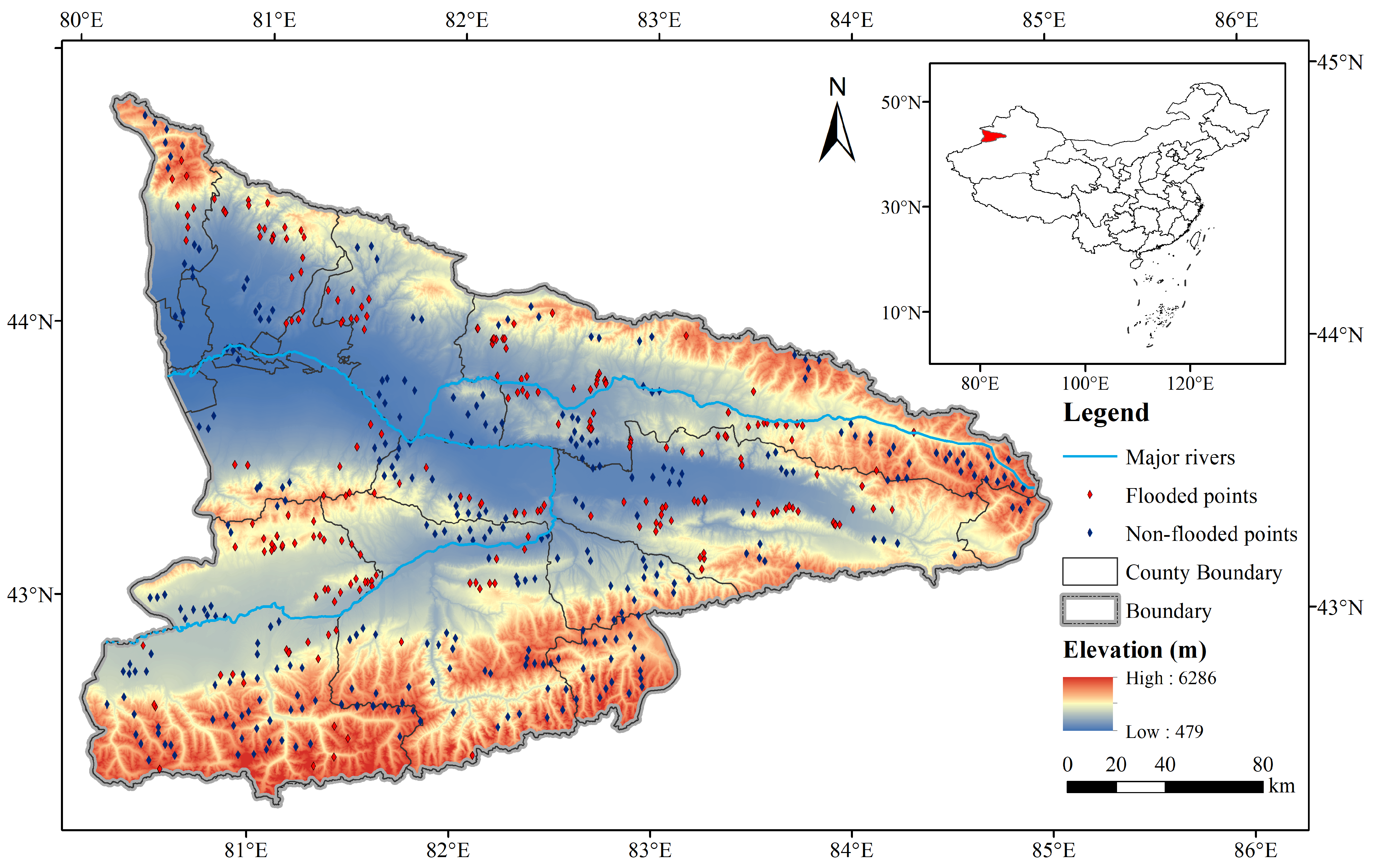
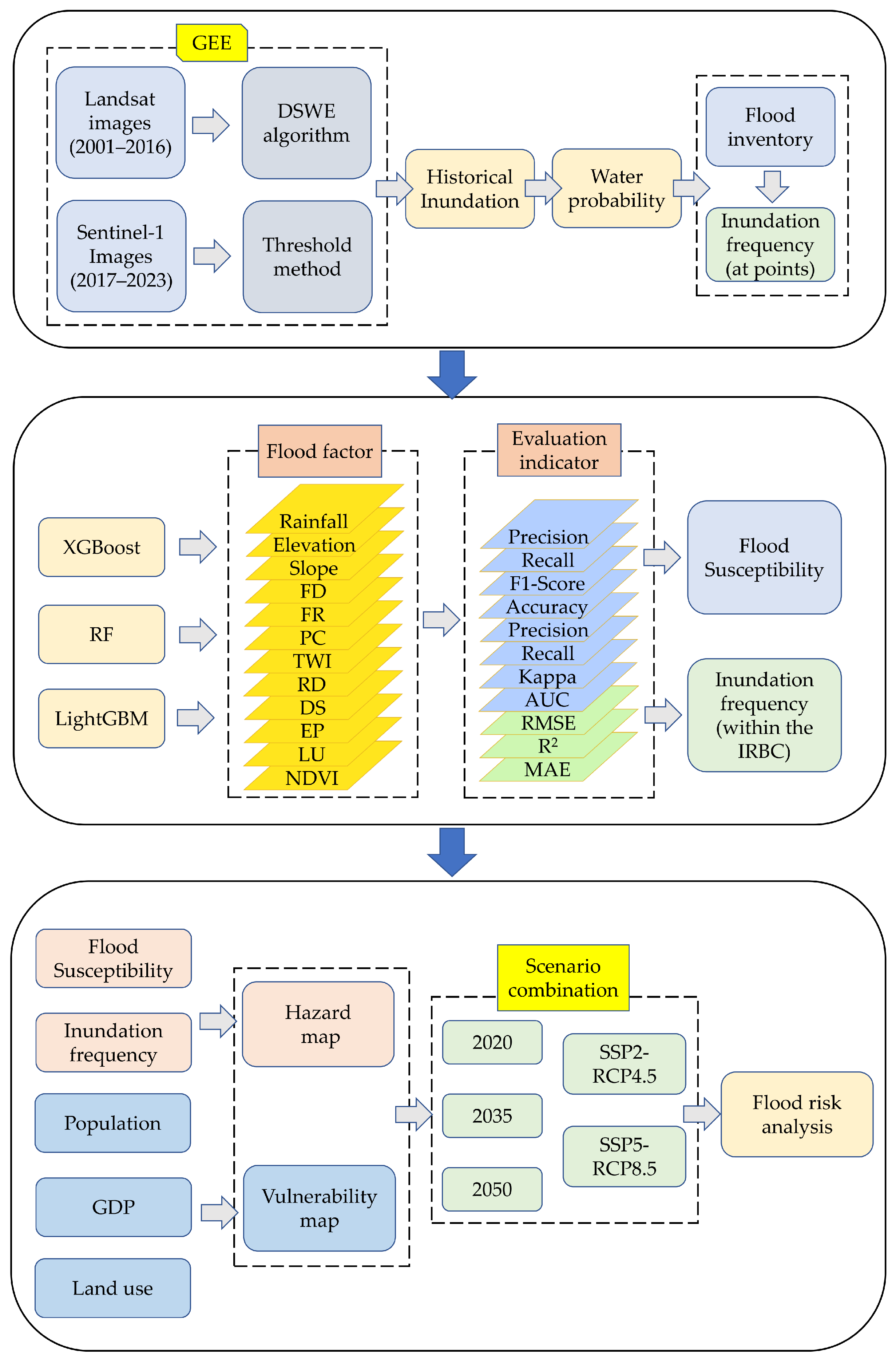

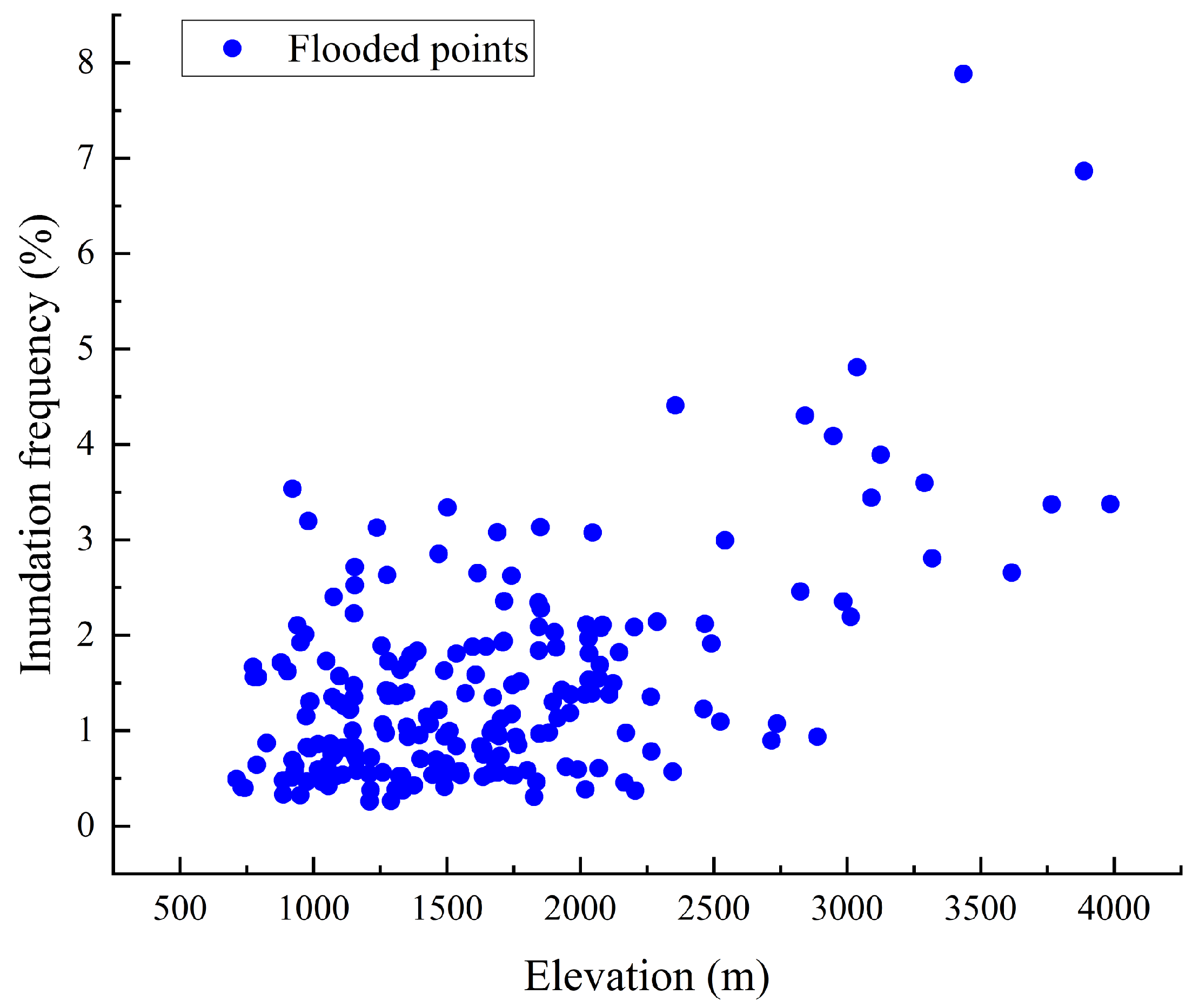

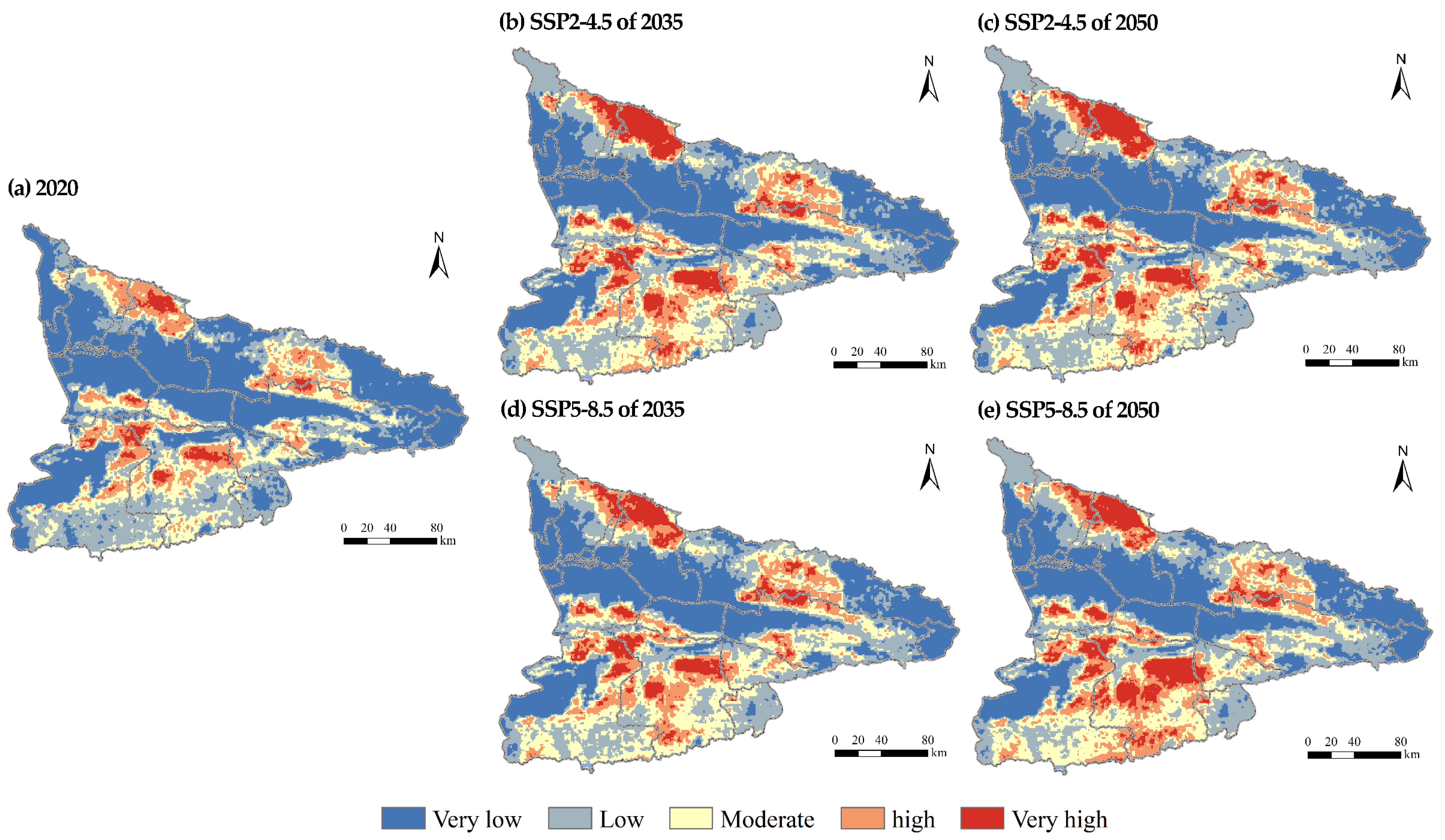


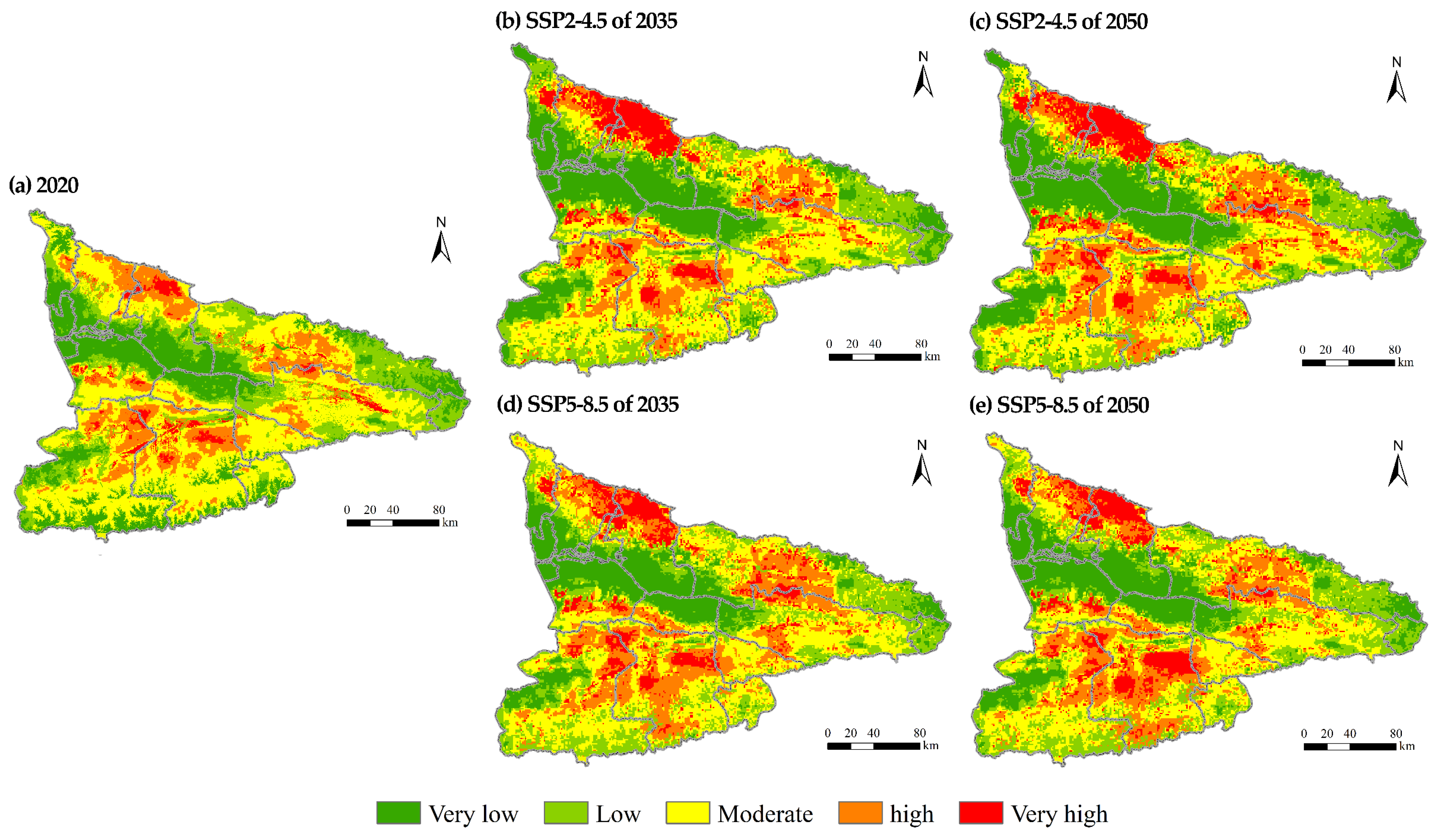
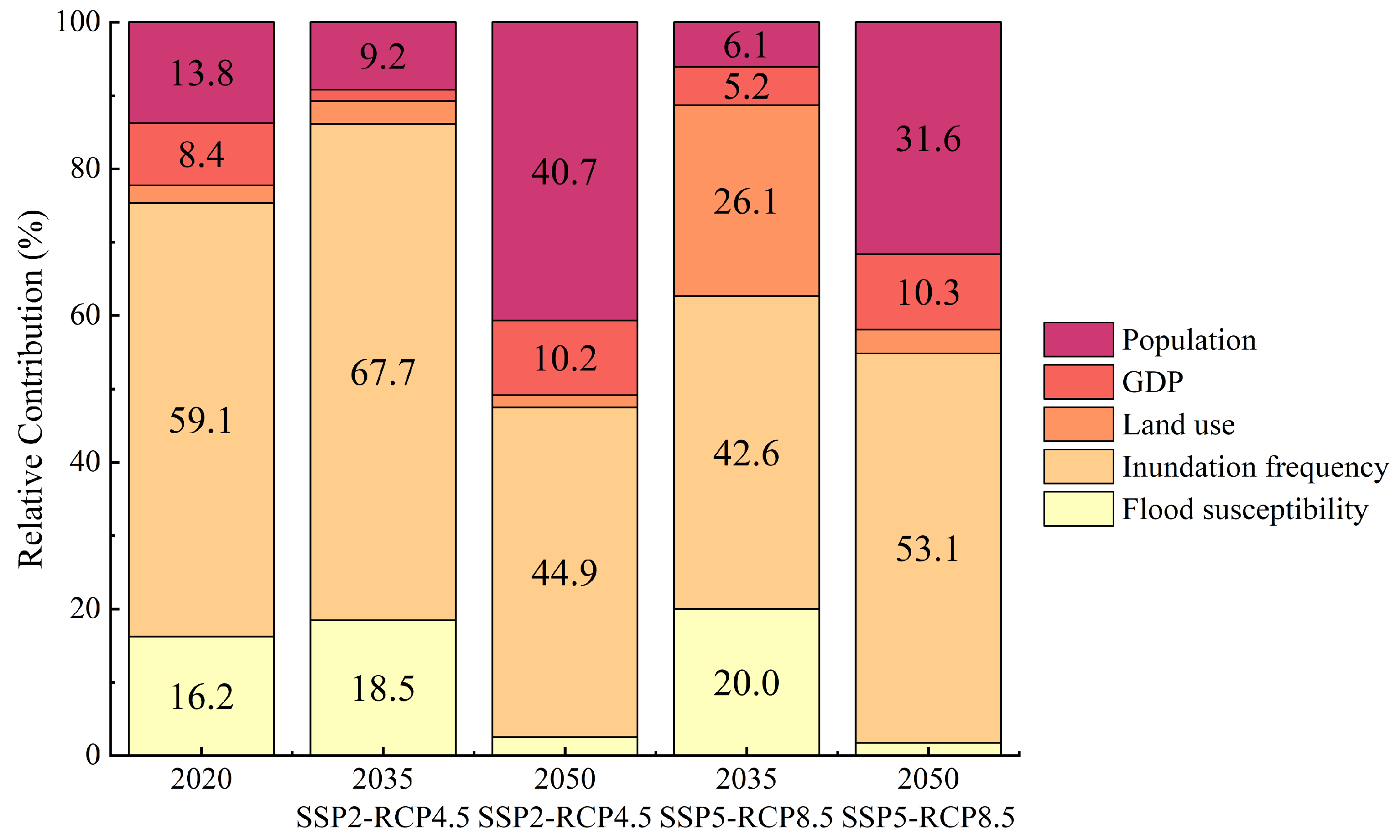
| Datasets | Period | Resolution | Source |
|---|---|---|---|
| Sentinel-1 GRD | 2017–2023 | 10 m | GEE |
| Landsat-5 TM and Landsat-7 ETM+ | 2001–2016 | 30 m | GEE |
| Annual maximum 1 h precipitation | 1980–2023 | 1 km | PANGAEA; Institute of Urumqi Desert Meteorology of CMA |
| 2015–2100 | 0.1° | NEX-GDDP-CMIP6 | |
| Annual maximum 24 h precipitation | 1980–2023 | 1 km | PANGAEA; Institute of Urumqi Desert Meteorology of CMA |
| 2015–2100 | 0.1° | NEX-GDDP-CMIP6 | |
| NDVI | 1986–2022 | 30 m | RESDC [46] |
| Evaporation | 2000–2022 | 500 m | MOD16A2 |
| Curve number | 2018 | 250 m | GCN250 dataset [45] |
| Land use | 1985–2022 | 30 m | 30 m annual land cover datasets [47] |
| 2020–2100 | 1 km | LULC projection datasets [48,49,50] | |
| Population | 2000–2020 | 100 m | WorldPop [51] |
| 2020–2100 | 1 km | Population projection datasets [52,53] | |
| GDP | 1995, 2000, 2005, 2010, 2015 and 2019 | 30 m | RESDC [54] |
| 2030–2100 | 0.25° | GDP projection datasets [52,55] |
| Model | Precision (%) | Recall (%) | F1-Score (%) | Accuracy (%) | Kappa |
|---|---|---|---|---|---|
| LightGBM | 89.19 | 86.84 | 88.00 | 88.08 | 0.76 |
| RF | 89.47 | 89.47 | 89.47 | 89.40 | 0.79 |
| XGBoost | 93.33 | 92.11 | 92.72 | 92.72 | 0.85 |
| Model | RMSE | R2 | MAE |
|---|---|---|---|
| LightGBM | 0.04 | 0.79 | 0.03 |
| RF | 0.03 | 0.82 | 0.02 |
| XGBoost | 0.01 | 0.96 | 0.01 |
| Area (%) | 2020 | 2035 | 2050 | Range | ||
|---|---|---|---|---|---|---|
| SSP2-4.5 | SSP5-8.5 | SSP2-4.5 | SSP5-8.5 | |||
| Very low | 33.6 | 35.3 | 33.8 | 35.2 | 33.9 | 0–0.03 |
| Low | 22.9 | 25.1 | 25.1 | 25.8 | 23.8 | 0.03–0.06 |
| Moderate | 25.9 | 18.6 | 20.8 | 19.0 | 18.6 | 0.06–0.09 |
| High | 15.1 | 13.3 | 13.2 | 12.1 | 15.1 | 0.09–0.11 |
| Very high | 2.6 | 7.7 | 7.0 | 7.9 | 8.6 | 0.11–0.16 |
| Area (%) | 2020 | 2035 | 2050 | Range | ||
|---|---|---|---|---|---|---|
| SSP2-4.5 | SSP5-8.5 | SSP2-4.5 | SSP5-8.5 | |||
| Very low | 83.75 | 71.07 | 74.29 | 70.60 | 73.70 | 0–0.15 |
| Low | 14.18 | 23.03 | 22.52 | 25.16 | 20.32 | 0.15–0.25 |
| Moderate | 1.65 | 4.83 | 2.72 | 3.50 | 5.82 | 0.25–0.29 |
| High | 0.38 | 0.91 | 0.33 | 0.69 | 0.14 | 0.29–0.41 |
| Very high | 0.04 | 0.15 | 0.13 | 0.05 | 0.02 | 0.41–0.93 |
| Area (%) | 2020 | 2035 | 2050 | Range | ||
|---|---|---|---|---|---|---|
| SSP2-4.5 | SSP5-8.5 | SSP2-4.5 | SSP5-8.5 | |||
| Very low | 24.6 | 23.7 | 25.5 | 19.0 | 20.7 | 0–0.005 |
| Low | 18.0 | 21.9 | 17.8 | 21.5 | 23.0 | 0.005–0.009 |
| Moderate | 39.4 | 30.0 | 27.5 | 30.5 | 28.6 | 0.009–0.018 |
| High | 14.4 | 14.9 | 18.9 | 20.1 | 20.2 | 0.018–0.024 |
| Very high | 3.5 | 9.4 | 10.3 | 8.9 | 9.5 | 0.024–0.046 |
Disclaimer/Publisher’s Note: The statements, opinions and data contained in all publications are solely those of the individual author(s) and contributor(s) and not of MDPI and/or the editor(s). MDPI and/or the editor(s) disclaim responsibility for any injury to people or property resulting from any ideas, methods, instructions or products referred to in the content. |
© 2025 by the authors. Licensee MDPI, Basel, Switzerland. This article is an open access article distributed under the terms and conditions of the Creative Commons Attribution (CC BY) license (https://creativecommons.org/licenses/by/4.0/).
Share and Cite
Zhang, M.; Fu, X.; Liu, S.; Zhang, C. Integrating Remote Sensing and Machine Learning for Actionable Flood Risk Assessment: Multi-Scenario Projection in the Ili River Basin in China Under Climate Change. Remote Sens. 2025, 17, 1189. https://doi.org/10.3390/rs17071189
Zhang M, Fu X, Liu S, Zhang C. Integrating Remote Sensing and Machine Learning for Actionable Flood Risk Assessment: Multi-Scenario Projection in the Ili River Basin in China Under Climate Change. Remote Sensing. 2025; 17(7):1189. https://doi.org/10.3390/rs17071189
Chicago/Turabian StyleZhang, Minjie, Xiang Fu, Shuangjun Liu, and Can Zhang. 2025. "Integrating Remote Sensing and Machine Learning for Actionable Flood Risk Assessment: Multi-Scenario Projection in the Ili River Basin in China Under Climate Change" Remote Sensing 17, no. 7: 1189. https://doi.org/10.3390/rs17071189
APA StyleZhang, M., Fu, X., Liu, S., & Zhang, C. (2025). Integrating Remote Sensing and Machine Learning for Actionable Flood Risk Assessment: Multi-Scenario Projection in the Ili River Basin in China Under Climate Change. Remote Sensing, 17(7), 1189. https://doi.org/10.3390/rs17071189





